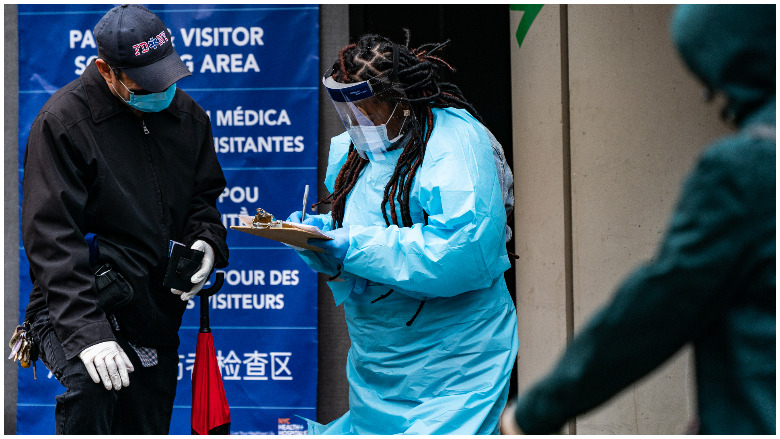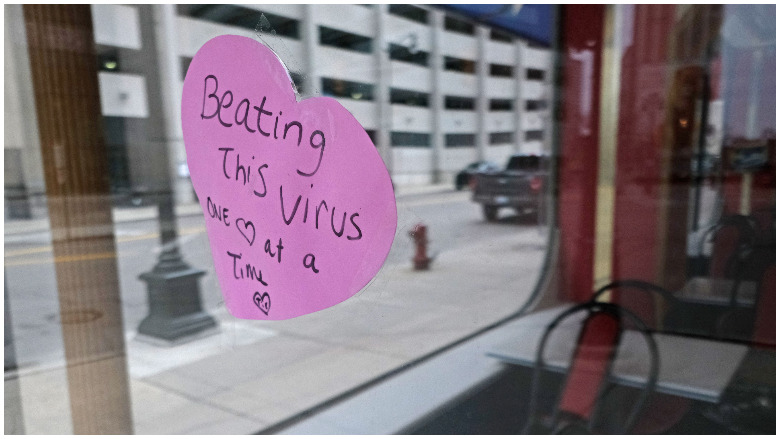
With COVID-19 still spreading throughout the country, many people are taking every precaution they can. However, we’re all in contact with different surfaces, whether it’s door knobs or packages full of takeout food. That begs the question: How long does COVID-19 live on surfaces?
Scientists are just beginning to understand the new coronavirus. However, some studies have documented the length of time that coronavirus can live on different surfaces. Furthermore, New York Governor Andrew Cuomo said in a news briefing that the virus “can linger in the air for up to three hours and survive for three days on plastic and steel surfaces commonly found on trains and buses.” He said the virus can live on a vinyl car seat or bus seat for up to 72 hours. Cuomo said the COVID-19 virus can live:
Up to 72 hours on plastic and stainless steel
Up to 24 hours on cardboard
Up to 4 hours on materials like copper
Can hang in the air for up to three hours
Here’s what you need to know:
Studies Found That Coronavirus Lives Longest on Stainless Steel & Plastic

Getty
Research studies have also found that the virus can live on surfaces.
For example, a research article called Aerosol and surface stability of HCoV-19 (SARS-CoV-2) compared to SARS-CoV-1 broke the virus survival time down by surface type.
“We found that viable virus 35 could be detected in aerosols up to 3 hours post aerosolization (particles in the air), up to 4 hours on copper, up to 24 hours on cardboard and up to 2-3 days on plastic and stainless steel,” the study found. “Both viruses show relatively long viability 38 on stainless steel and polypropylene compared to copper or cardboard: the median half-life estimate for 39 HCoV-19 is around 13 hours on steel and around 16 hours on polypropylene,” the study, which compared COVID-19 to SARS, found. To break that down into common language:
In the air: Up to 3 hours
On copper: Up to 4 hours
On cardboard: Up to 24 hours
On plastic: 2 to 3 days
On stainless steel: 2 to 3 days
Despite the fact that studies have found the virus can live on surfaces, the Centers for Disease Control and Prevention points out that this is not the main way COVID-19 spreads. Person-to-person contact is the biggest risk. “The virus is thought to spread mainly from person-to-person,” CDC wrote. “Between people who are in close contact with one another (within about 6 feet). Through respiratory droplets produced when an infected person coughs or sneezes. These droplets can land in the mouths or noses of people who are nearby or possibly be inhaled into the lungs.”
The CDC does add, though: “It may be possible that a person can get COVID-19 by touching a surface or object that has the virus on it and then touching their own mouth, nose, or possibly their eyes, but this is not thought to be the main way the virus spreads.”
Thus far, the CDC doesn’t see great risk in ingesting food, writing:
Coronaviruses are generally thought to be spread from person-to-person through respiratory droplets. Currently there is no evidence to support transmission of COVID-19 associated with food. Before preparing or eating food it is important to always wash your hands with soap and water for 20 seconds for general food safety. Throughout the day wash your hands after blowing your nose, coughing or sneezing, or going to the bathroom.
CDC does note:
It may be possible that a person can get COVID-19 by touching a surface or object that has the virus on it and then touching their own mouth, nose, or possibly their eyes, but this is not thought to be the main way the virus spreads. In general, because of poor survivability of these coronaviruses on surfaces, there is likely very low risk of spread from food products or packaging that are shipped over a period of days or weeks at ambient, refrigerated, or frozen temperatures.
According to the National Post of Canada, “High-touch surfaces such as toys, toilets, phones, electronics, door handles and TV remotes should be cleaned regularly.”
Dr. Julia Marcus, an infectious disease epidemiologist and professor, told National Post: “The potential risk is that an infected person recently handled our groceries, and then we touch those items and go on to touch our eyes, nose, or mouth. There are several ways to reduce this risk, including letting the groceries sit untouched for some time, disposing of outer food packaging, or disinfecting hard surfaces like bottles or cans, but the most important thing is to wash your hands well after handling anything new that comes into your home.”
Here’s a useful instructional video showing a technique for sanitizing groceries:
The expert in the video, Dr. Jeffrey VanWingen, MD, said that risk comes with “movement.” He borrowed from a medical term called “sterile technique,” which is used in surgeries, and adapted it to grocery shopping. He suggests not using groceries for three days and leaving them in the garage; having a delivery person leave them outside is better. You want contact-free delivery. If you go to the store, wipe down your shopping cart. Stay away from the store if you have signs of respiratory illness, and don’t let people over age 60 shop. Get two weeks of groceries and minimize your time in the store. Once you get the groceries home, sanitize your workplace. Put the groceries on the non-clean side of the table and systematically sanitize them with disinfectant wipes. Wipe down bottles. With items like cardboard cereal boxes, get rid of the box. Cloth bags increase risk and should be consider dirty; put them outside after use. This is all according to Dr. VanWingen. He suggests washing fruit with soap and water for 20 seconds as if it’s your hands.
More importantly, it’s a good idea to limit contact with people, because the virus generally spreads through respiratory droplets. That includes the person delivering the groceries, other shoppers or the person checking you out.
The U.S. Food & Drug Administration wrote:
… the U.S. food supply remains safe for both people and animals. There is no evidence of human or animal food or food packaging being associated with transmission of the coronavirus that causes COVID-19.” The FDA added, “Unlike foodborne gastrointestinal viruses like norovirus and hepatitis A that make people ill through contaminated food, SARS-CoV-2, which causes COVID-19, is a virus that causes respiratory illness. This virus is thought to spread mainly from person to person. Foodborne exposure to this virus is not known to be a route of transmission.
The United States Environmental Protection Agency has released an expanded list of disinfectants and cleaners that destroy COVID-19. Here’s that list.
The CDC adds:
Community members can practice routine cleaning of frequently touched surfaces (for example: tables, doorknobs, light switches, handles, desks, toilets, faucets, sinks) with household cleaners and EPA-registered disinfectants that are appropriate for the surface, following label instructions. Labels contain instructions for safe and effective use of the cleaning product including precautions you should take when applying the product, such as wearing gloves and making sure you have good ventilation during use of the product.
READ NEXT: The Real Story of Waco.